Modelling Winter Rapeseed (Brassica napus L.) Growth and Yield under Different Sowing Dates and Densities Using AquaCrop Model
Abstract
1. Introduction
2. Materials and Methods
2.1. Study Area
2.2. Experimental Design
2.3. Field Data Collection
2.3.1. Canopy Cover
2.3.2. Aboveground Dry Biomass and Yield
2.3.3. Crop Evapotranspiration
2.4. Model Description
- (1)
- The crop development process: AquaCrop employs the CC to describe the development of crops. Three parameters of the initial canopy coverage, maximum canopy coverage and canopy growth coefficient were used to determine the dynamic of the crop canopy coverage.
- (2)
- Crop evapotranspiration: ET simulation is divided into Tr and E. Based on the given meteorological data, the reference evapotranspiration (ET0) is calculated by the Penmane–Monteith equation in the FAO Irrigation and Drainage Paper No. 566 [35]. Tr is calculated by the product of ET0 and the crop transpiration coefficient (KcTr), and the KcTr is proportional with the CC. Soil evaporation is calculated by multiplying ET0 with the soil evaporation coefficient, a coefficient that relates to the fraction of uncovered soil surface.
- (3)
- Biomass: The output of the model simulation biomass was the AGB, excluding root and tuber crops. The model uses normalized water productivity (WP*) and Tr for estimating the biomass (Equation (3)). The WP* indicates the produced dry matter (g) per unit land area (m2) per unit of transpired water amount (mm). The WP* can be supposed to be the constant of the given crops and growth conditions (e.g., C3 crops: 15–20 g·m−2, C4 crops: 30–35 g·m−2) suggested by Steduto et al. [37].
- (4)
- Crop yield: After determining the crop biomass, the yield formation is obtained by the product of biomass and HI (Equation (4)).
2.5. Input Data and Model Calibration
2.5.1. Weather Data
2.5.2. Crop Parameters Calibration
2.5.3. Management Practices
2.6. Model Evaluation and Validation
3. Results and Discussion
3.1. Phenological Days
3.2. Canopy Cover
3.3. Crop Evapotranspiration
3.4. Biomass and Grain Yield
3.5. Optimum Sowing Date and Density
4. Conclusions
Author Contributions
Funding
Data Availability Statement
Acknowledgments
Conflicts of Interest
References
- Wang, H.; Yin, Y. Analysis and strategy for oil crop industry in China. Chin. J. Oil Crop Sci. 2014, 36, 414–421. [Google Scholar]
- National Bureau of Statistics of China. China Statistical Yearbook; China Statistical Press: Beijing, China, 2021. Available online: www.stats.gov.cn (accessed on 1 June 2022).
- Wang, H.; Chen, X.; Hu, F. Adaptative adjustments of the sowing date of late season rice under climate change in Guangdong Province. ACTA Ecol. Sin. 2011, 15, 4261–4269. [Google Scholar]
- Ozer, H. Sowing date and nitrogen rate effects on growth, yield and yield components of two summer rapeseed cultivars. Eur. J. Agron. 2003, 19, 453–463. [Google Scholar] [CrossRef]
- Weymann, W.; Böttcher, U.; Sieling, K.; Kage, H. Effects of weather conditions during different growth phases on yield formation of winter oilseed rape. Field Crops Res. 2015, 173, 41–48. [Google Scholar] [CrossRef]
- Kirkegaard, J.; Lilley, J.; Brill, R.; Sprague, S.; Fettell, N.; Pengilley, G. Re-evaluating sowing time of spring canola (Brassica napus L.) in south-eastern Australia—How early is too early? Crop Pasture Sci. 2016, 67, 381–396. [Google Scholar] [CrossRef]
- Mao, L.; Zhang, L.; Zhao, X.; Liu, S.; van der Werf, W.; Zhang, S.; Spiertz, H.; Li, Z. Crop growth, light utilization and yield of relay intercropped cotton as affected by plant density and a plant growth regulator. Field Crops Res. 2014, 155, 67–76. [Google Scholar] [CrossRef]
- McGregor, D. Effect of plant density on development and yield of rapeseed and its significance to recovery from hail injury. Can. J. Plant Sci. 1987, 67, 43–51. [Google Scholar] [CrossRef]
- Griesh, M.; Yakout, G. Effect of plant population density and nitrogen fertilization on yield and yield components of some white and yellow maize hybrids under drip irrigation system in sandy soil. In Plant Nutrition; Springer: Berlin/Heidelberg, Germany, 2001; pp. 810–811. [Google Scholar]
- Sandhu, R.; Irmak, S. Assessment of AquaCrop model in simulating maize canopy cover, soil-water, evapotranspiration, yield, and water productivity for different planting dates and densities under irrigated and rainfed conditions. Agric. Water Manag. 2019, 224, 105753. [Google Scholar] [CrossRef]
- Al-Doori, S.A.M. A study of the importance of sowing dates and plant density affecting some rapeseed cultivars (Brassica napus L.). Coll. Basic Educ. Res. J. 2011, 11, 615–632. [Google Scholar]
- Vincze, E. The effect of sowing date and plant density on yield elements of different winter oilseed rape (Brassica napus var. napus f. biennis L.) genotypes. Columella J. Agric. Environ. Sci. 2017, 4, 21–25. [Google Scholar]
- Gusta, L.; Johnson, E.; Nesbitt, N.; Kirkland, K. Effect of seeding date on canola seed quality and seed vigour. Can. J. Plant Sci. 2004, 84, 463–471. [Google Scholar] [CrossRef]
- Guan, C.; Chen, S. Investigation on planting density of double low rapeseed “Xiangyou 15”. Crop Res. 2003, 17, 136–137. [Google Scholar]
- Li, X.; Zuo, Q.; Chang, H.; Bai, G.; Kuai, J.; Zhou, G. Higher density planting benefits mechanical harvesting of rapeseed in the Yangtze River Basin of China. Field Crops Res. 2018, 218, 97–105. [Google Scholar] [CrossRef]
- He, D.; Wang, E.; Wang, J.; Robertson, M.J. Data requirement for effective calibration of process-based crop models. Agric. For. Meteorol. 2017, 234, 136–148. [Google Scholar] [CrossRef]
- ur Rahman, M.H.; Ahmad, A.; Wang, X.; Wajid, A.; Nasim, W.; Hussain, M.; Ahmad, B.; Ahmad, I.; Ali, Z.; Ishaque, W. Multi-model projections of future climate and climate change impacts uncertainty assessment for cotton production in Pakistan. Agric. For. Meteorol. 2018, 253, 94–113. [Google Scholar] [CrossRef]
- Rodriguez, D.; De Voil, P.; Hudson, D.; Brown, J.; Hayman, P.; Marrou, H.; Meinke, H. Predicting optimum crop designs using crop models and seasonal climate forecasts. Sci. Rep. 2018, 8, 2231. [Google Scholar] [CrossRef] [PubMed]
- Nunes, H.; Farias, V.; Sousa, D.; Costa, D.; Pinto, J.; Moura, V.; Teixeira, E.; Lima, M.; Ortega-Farias, S.; Souza, P. Parameterization of the AquaCrop model for cowpea and assessing the impact of sowing dates normally used on yield. Agric. Water Manag. 2021, 252, 106880. [Google Scholar] [CrossRef]
- Chen, S.; Jiang, T.; Ma, H.; He, C.; Xu, F.; Malone, R.W.; Feng, H.; Yu, Q.; Siddique, K.H.; He, J. Dynamic within-season irrigation scheduling for maize production in Northwest China: A Method Based on Weather Data Fusion and yield prediction by DSSAT. Agric. For. Meteorol. 2020, 285, 107928. [Google Scholar] [CrossRef]
- Zadeh, S.F.M.; Honar, T.; Rahmati, H. Simulation of Seed Yield and Dry Matter of Canola Under The Condition of Water Stress Using SWAP Model. Irrig. Sci. Eng. 1970, 40, 153–165. [Google Scholar]
- Jing, Q.; Shang, J.; Qian, B.; Hoogenboom, G.; Huffman, T.; Liu, J.; Ma, B.L.; Geng, X.; Jiao, X.; Kovacs, J.; et al. Evaluation of the CSM-CROPGRO-Canola Model for Simulating Canola Growth and Yield at West Nipissing in Eastern Canada. Agron. J. 2016, 108, 575–584. [Google Scholar] [CrossRef]
- He, D.; Wang, E.; Wang, J.; Lilley, J.; Luo, Z.; Pan, X.; Pan, Z.; Yang, N. Uncertainty in canola phenology modelling induced by cultivar parameterization and its impact on simulated yield. Agric. For. Meteorol. 2017, 232, 163–175. [Google Scholar] [CrossRef]
- Qian, B.; Jing, Q.; Zhang, X.; Shang, J.; Liu, J.; Wan, H.; Dong, T.; De Jong, R. Adapting estimation methods of daily solar radiation for crop modelling applications in Canada. Can. J. Soil Sci. 2019, 99, 533–547. [Google Scholar] [CrossRef]
- Abedinpour, M.; Sarangi, A.; Rajput, T.; Singh, M.; Pathak, H.; Ahmad, T. Performance evaluation of AquaCrop model for maize crop in a semi-arid environment. Agric. Water Manag. 2012, 110, 55–66. [Google Scholar] [CrossRef]
- Toumi, J.; Er-Raki, S.; Ezzahar, J.; Khabba, S.; Jarlan, L.; Chehbouni, A. Performance assessment of AquaCrop model for estimating evapotranspiration, soil water content and grain yield of winter wheat in Tensift Al Haouz (Morocco): Application to irrigation management. Agric. Water Manag. 2016, 163, 219–235. [Google Scholar] [CrossRef]
- Steduto, P.; Raes, D.; Hsiao, T.C.; Fereres, E.; Heng, L.K.; Howell, T.A. Concepts and applications of AquaCrop: The FAO crop water productivity model. In Crop Modeling and Decision Aupport; Springer: Berlin/Heidelberg, Germany, 2009; pp. 175–191. [Google Scholar]
- Katerji, N.; Campi, P.; Mastrorilli, M. Productivity, evapotranspiration, and water use efficiency of corn and tomato crops simulated by AquaCrop under contrasting water stress conditions in the Mediterranean region. Agric. Water Manag. 2013, 130, 14–26. [Google Scholar] [CrossRef]
- Steduto, P.; Hsiao, T.C.; Raes, D.; Fereres, E. AquaCrop—The FAO crop model to simulate yield response to water: I. Concepts and underlying principles. Agron. J. 2009, 101, 426–437. [Google Scholar] [CrossRef]
- Sun, S.; Zhang, L.; Chen, Z.; Sun, J. Advances in AquaCrop model research and application. Sci. Agric. Sin. 2017, 50, 3286–3299. [Google Scholar]
- Zhang, C.; Xie, Z.; Shang, J.; Liu, J.; Dong, T.; Tang, M.; Feng, S.; Cai, H. Detecting winter canola (Brassica napus) phenological stages using an improved shape-model method based on time-series UAV spectral data. Crop J. 2022, 10, 1353–1362. [Google Scholar] [CrossRef]
- Purevdorj, T.; Tateishi, R.; Ishiyama, T.; Honda, Y. Relationships between percent vegetation cover and vegetation indices. Int. J. Remote Sens. 1998, 19, 3519–3535. [Google Scholar] [CrossRef]
- Jiapaer, G.; Chen, X.; Bao, A. A comparison of methods for estimating fractional vegetation cover in arid regions. Agric. For. Meteorol. 2011, 151, 1698–1710. [Google Scholar] [CrossRef]
- Niu, Y.; Zhang, L.; Han, W.; Shao, G. Fractional vegetation cover extraction method of winter wheat based on UAV remote sensing and vegetation index. Trans. CSAM 2018, 49, 213–221. [Google Scholar]
- Allen, R.G.; Pereira, L.S.; Raes, D.; Smith, M. Crop Evapotranspiration-Guidelines for Computing Crop Water Requirements-FAO Irrigation and Drainage Paper 56; Fao: Rome, Italy, 1998; Volume 300, p. D05109. [Google Scholar]
- Doorenbos, J.; Kassam, A. Yield response to water. In Irrigation and Drainage Paper; Elsevier: Amsterdam, The Netherlands, 1979; Volume 33, p. 257. [Google Scholar]
- Steduto, P.; Hsiao, T.C.; Fereres, E. On the conservative behavior of biomass water productivity. Irrig. Sci. 2007, 25, 189–207. [Google Scholar] [CrossRef]
- Zeleke, K.T.; Luckett, D.; Cowley, R. Calibration and Testing of the FAO AquaCrop Model for Canola. Agron. J. 2011, 103, 1610–1618. [Google Scholar] [CrossRef]
- Dirwai, T.L.; Senzanje, A.; Mabhaudhi, T. Calibration and Evaluation of the FAO AquaCrop Model for Canola (Brassica napus) under Varied Moistube Irrigation Regimes. Agriculture 2021, 11, 410. [Google Scholar] [CrossRef]
- Zhou, M.; Ma, X.; Wang, K.; Cheng, T.; Tian, Y.; Wang, J.; Zhu, Y.; Hu, Y.; Niu, Q.; Gui, L.; et al. Detection of phenology using an improved shape model on time-series vegetation index in wheat. Comput. Electron. Agric. Comput. Electron. Agric. 2020, 173, 105398. [Google Scholar] [CrossRef]
- Mandal, D.; Kumar, V.; Ratha, D.; Dey, S.; Bhattacharya, A.; Lopez-Sanchez, J.M.; McNairn, H.; Rao, Y.S. Dual polarimetric radar vegetation index for crop growth monitoring using sentinel-1 SAR data. Remote Sens. Environ. 2020, 247, 111954. [Google Scholar] [CrossRef]
- Schlund, M.; Erasmi, S. Sentinel-1 time series data for monitoring the phenology of winter wheat. Remote Sens. Environ. 2020, 246, 111814. [Google Scholar] [CrossRef]
- Harker, K.; O’Donovan, J.; Smith, E.; Johnson, E.; Peng, G.; Willenborg, C.; Gulden, R.; Mohr, R.; Gill, K.; Grenkow, L. Seed size and seeding rate effects on canola emergence, development, yield and seed weight. Can. J. Plant Sci. 2015, 95, 1–8. [Google Scholar] [CrossRef]
- Shah, S.; Akmal, M. Effect of different sowing date on yield and yield components of wheat varieties. Sarhad J. Agric. 2002, 1016, 4383. [Google Scholar] [CrossRef]
- Jiang, H.; Sun, W.; Zeng, X.; Chen, J.; Shi, P.; Zhao, C.; Li, H. Effect of sowing date on Brassica rape growth and yield in northern China. Chin. J. Oil Crop Sci. 2012, 34, 6. [Google Scholar]
- Serafin-Andrzejewska, M.; Helios, W.; Jama-Rodzeńska, A.; Kozak, M.; Kotecki, A.; Kuchar, L. Effect of Sowing Date on Soybean Development in South-Western Poland. Agriculture 2021, 11, 413. [Google Scholar] [CrossRef]
- Nanda, R.; Bhargava, S.; Tomar, D.; Rawson, H. Phenological development of Brassica campestris, B. juncea, B. napus and B. carinata grown in controlled environments and from 14 sowing dates in the field. Field Crops Res. 1996, 46, 93–103. [Google Scholar] [CrossRef]
- Cai, F.; Zhang, Y.; Mi, N.; Ming, H.; Zhang, S.; Zhang, H.; Zhao, X.; Zhang, B. The Effect of Drought and Sowing Date on Dry Matter Accumulation and Partitioning in the Above-Ground Organs of Maize. Atmosphere 2022, 13, 677. [Google Scholar] [CrossRef]
- Sun, W.; Wu, J.; Fang, Y.; Liu, Q.; Yang, R.; Ma, W.; Li, X.; Zhang, J.; Zhang, P.; Lei, J. Growth and development characteristics of winter rapeseed northern-extended from the cold and arid regions in China. Acta Agron. Sin. 2010, 36, 2124–2134. [Google Scholar] [CrossRef]
- Guan, C.; Jin, F.; Dong, G.; Guan, M.; Tan, T. Exploring the growth and development properties of early variety of winter rapeseed. Eng. Sci. 2012, 14, 4–12. [Google Scholar]
- Cong, R.; Zhang, Z.; Lu, J. Climate impacts on yield of winter oilseed rape in different growth regions of the Yangtze River Basin. Chin. J. Oil Crop Sci. 2019, 41, 894. [Google Scholar]
- Raja, W.; Kanth, R.H.; Singh, P. Validating the AquaCrop model for maize under different sowing dates. Water Policy 2018, 20, 826–840. [Google Scholar] [CrossRef]
- Begna, S.H.; Angadi, S.V. Effects of planting date on winter canola growth and yield in the southwestern US. Am. J. Plant Sci. 2016, 7, 201–217. [Google Scholar] [CrossRef]
- Li, G.; Guan, C. Study on characteristics of dry matter accumulation, distribution and transfer of winter rapeseed (Brassica napus). Zuo Wu Xue Bao 2002, 28, 52–58. [Google Scholar]
- Pal, R.; Mahajan, G.; Sardana, V.; Chauhan, B. Impact of sowing date on yield, dry matter and nitrogen accumulation, and nitrogen translocation in dry-seeded rice in North-West India. Field Crops Res. 2017, 206, 138–148. [Google Scholar] [CrossRef]
- Wang, R.; Cheng, T.; Hu, L. Effect of wide–narrow row arrangement and plant density on yield and radiation use efficiency of mechanized direct-seeded canola in Central China. Field Crops Res. 2015, 172, 42–52. [Google Scholar] [CrossRef]
- Harker, K.; O’Donovan, J.; Blackshaw, R.; Johnson, E.; Lafond, G.; May, W. Seeding depth and seeding speed effects on no-till canola emergence, maturity, yield and seed quality. Can. J. Plant Sci. 2012, 92, 795–802. [Google Scholar] [CrossRef]
- Jabran, K.; Cheema, Z.; Farooq, M.; Hussain, M. Lower doses of pendimethalin mixed with allelopathic crop water extracts for weed management in canola (Brassica napus). Int. J. Agric. Biol. 2010, 12, 335–340. [Google Scholar]
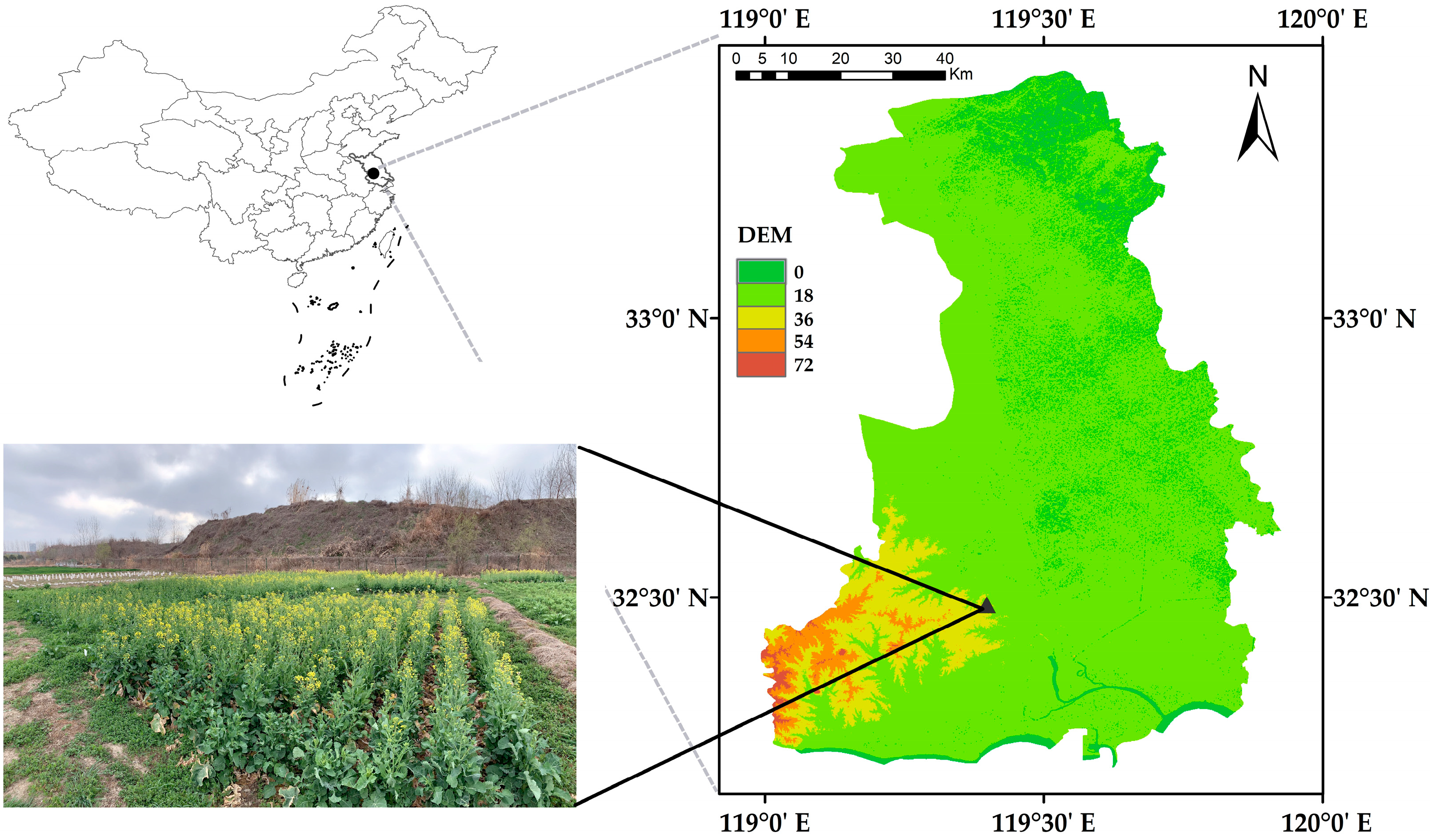


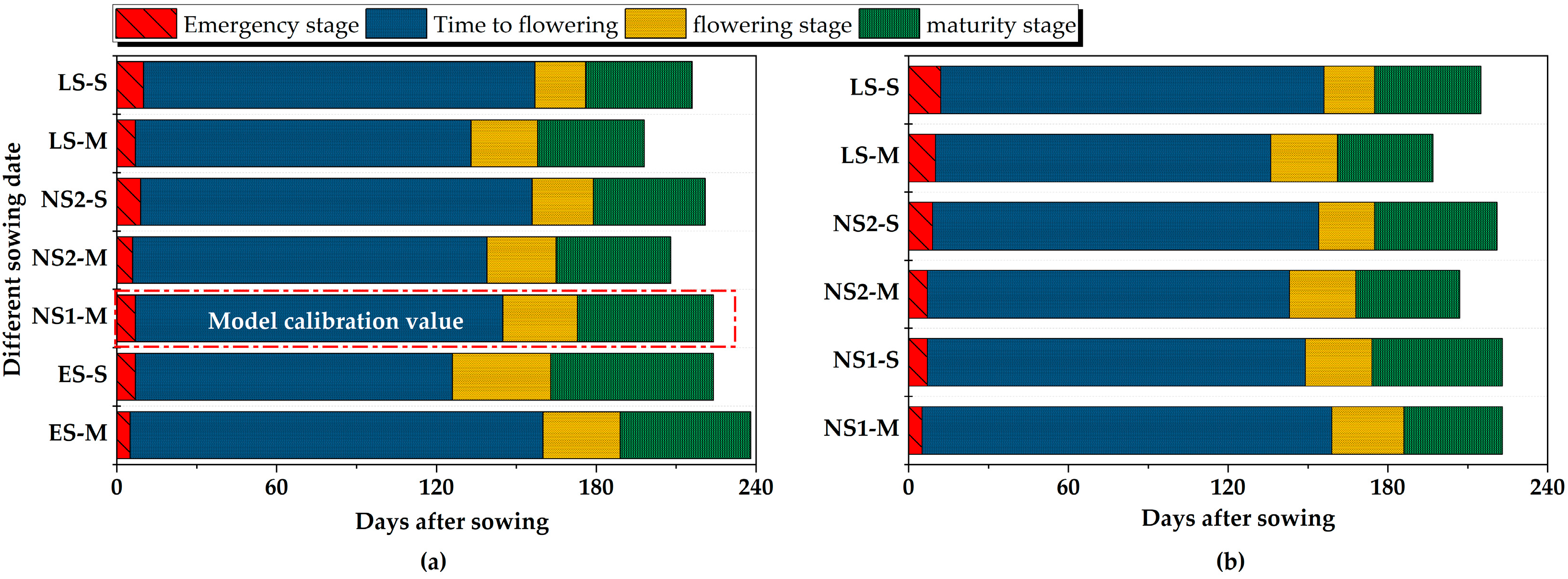
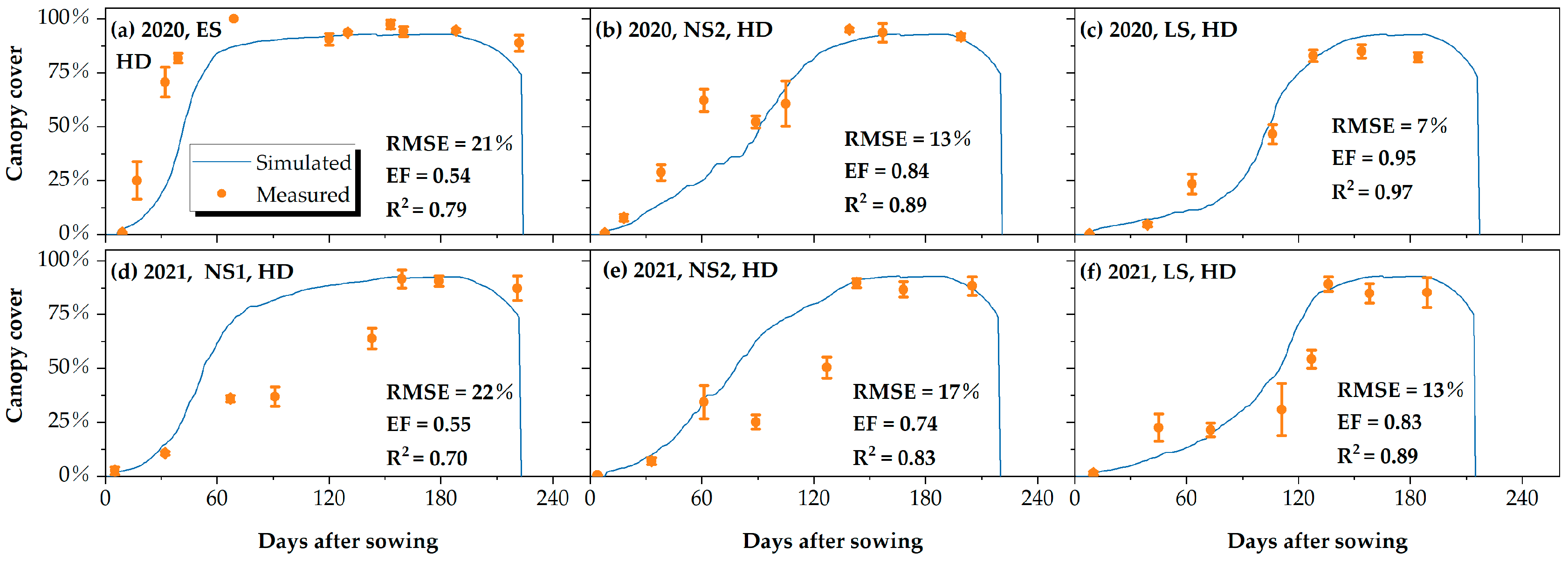
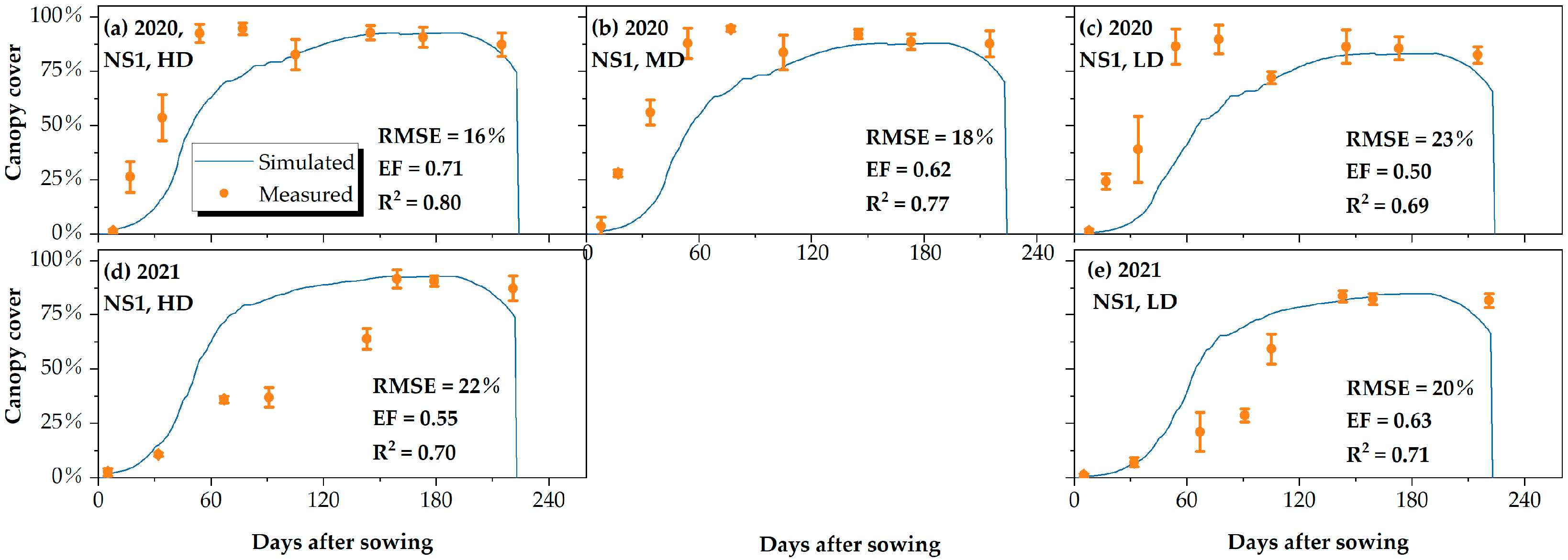
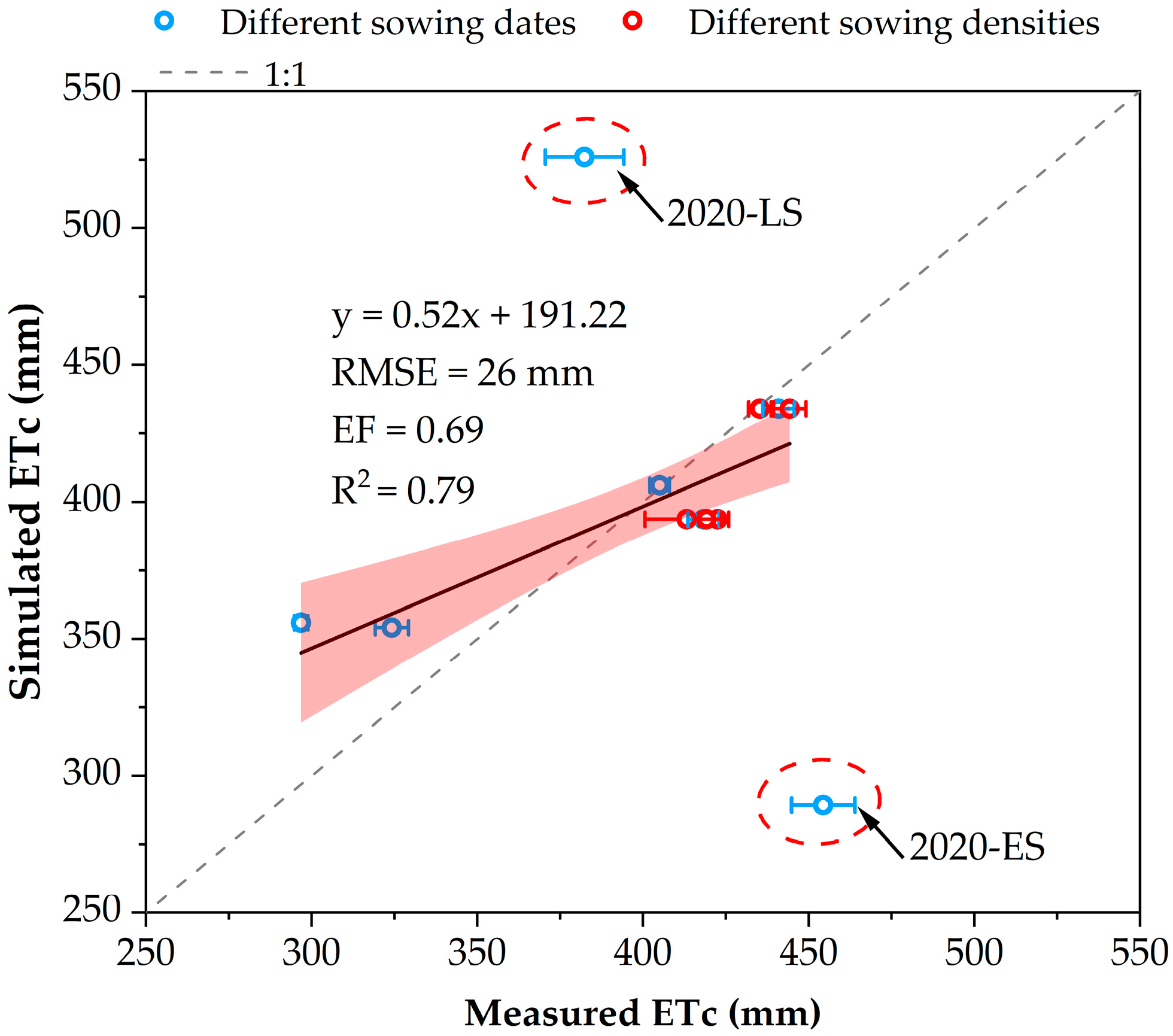
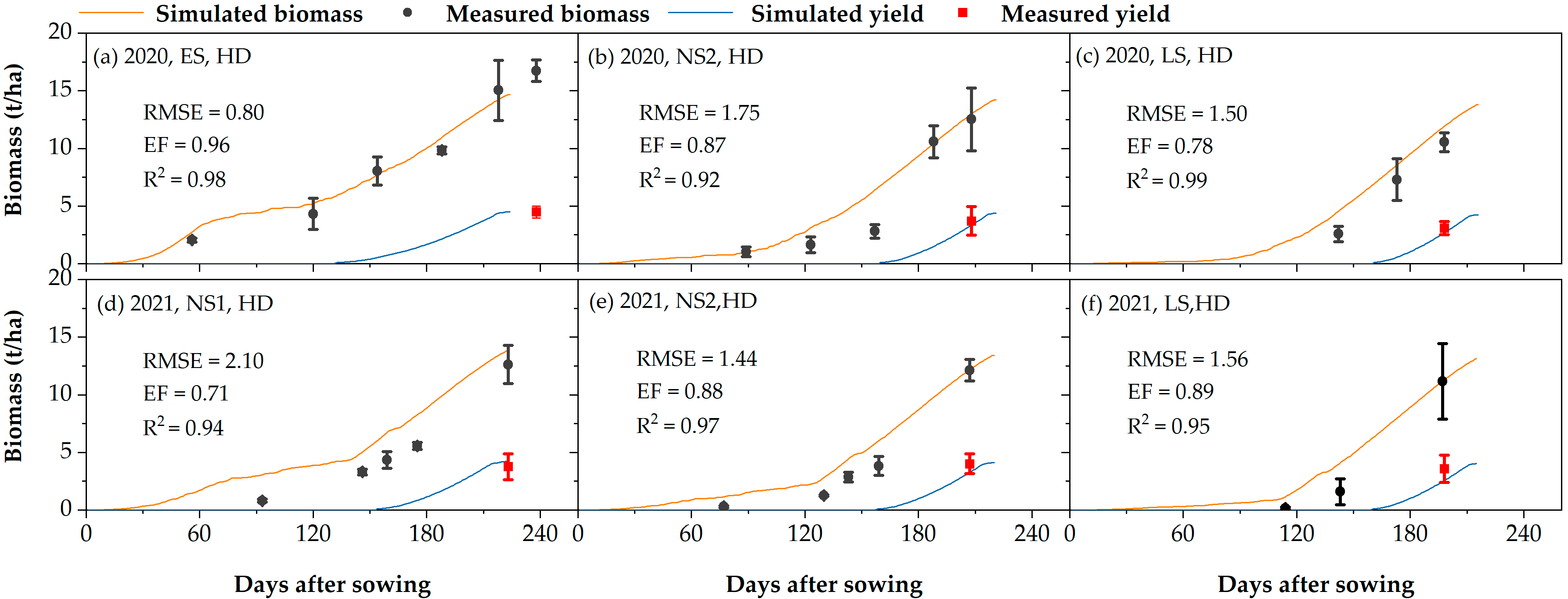
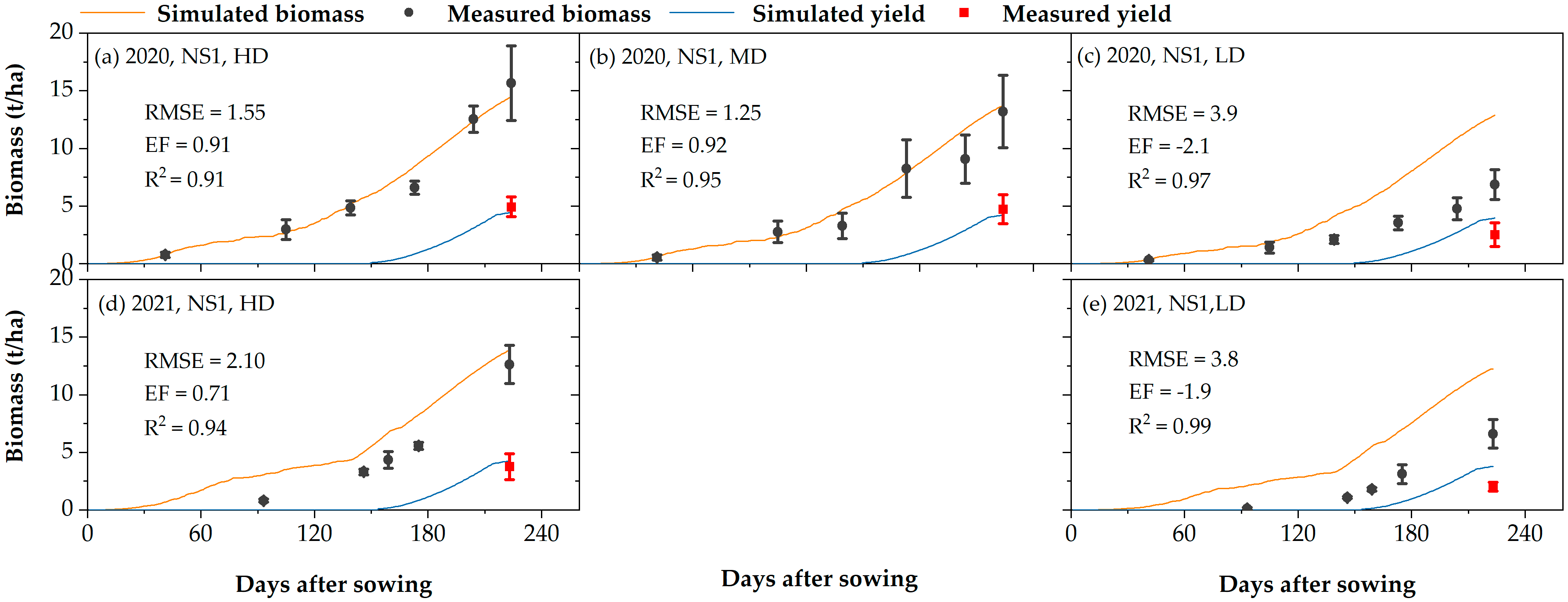
| Growth Cycle | Sowing Density | Sowing Date | |||
|---|---|---|---|---|---|
| ES | NS1 | NS2 | LS | ||
| September 2020–May 2021 | LD (12.5 plants·m−2) | 9.21 | 10.06 | 10.23 | 11.06 |
| MD (25.0 plants·m−2) | 9.21 | 10.06 | 10.23 | 11.06 | |
| HD (37.5 plants·m−2) | 9.21 | 10.06 | 10.23 | 11.06 | |
| October 2021–May 2022 | LD (12.5 plants·m−2) | - | 10.08 | 10.23 | 11.09 |
| HD (37.5 plants·m−2) | - | 10.08 | 10.23 | 11.09 | |
| Parameter Description | Value | Unit | |
|---|---|---|---|
| Inputs | Daily air temperature (maximum and minimum) | °C | |
| Daily precipitation | mm | ||
| Daily relative humidity | % | ||
| Daily solar radiation | MJ·m−2 | ||
| Initial soil moisture | vol% | ||
| Parameter | Conservative | ||
| Canopy decline coefficient | 5.2 | %·day−1 | |
| Minimum effective rooting depth | 0.3 | m | |
| Maximum effective rooting depth | 1 | m | |
| Root zone expansion curve shape | 0.6 | cm·day−1 | |
| Basal crop coefficient (maximum) | 0.95 | ||
| Normalized water productivity | 15 | g·m−2 | |
| Reference harvest index | 30 | % | |
| Soil water depletion factor for canopy expansion threshold-upper | 0.2 | ||
| Soil water depletion factor for canopy expansion threshold-lower | 0.55 | ||
| Soil water depletion factor for canopy expansion stress coefficient curve shape | 3.5 | ||
| Soil water depletion factor for stomatal control threshold-upper | 0.6 | ||
| Soil water depletion factor for stomatal stress coefficient curve shape | 5 | ||
| Soil water depletion factor for canopy Senescence stress coefficient-upper | 0.7 | ||
| Soil water depletion factor for senescence stress coefficient curve shape | 3 | ||
| Base temperature | 0 | °C | |
| Upper temperature | 30 | °C | |
| Crop transpiration affected by cold stress | 16.5 | °C | |
| Minimum temperature of pollination fail | 5 | °C | |
| Maximum temperature of pollination fail | 35 | °C | |
| Non-conservative | |||
| Plant density | 125,000, 250,000, 375,000 | plants·ha−1 | |
| Initial canopy cover | 0.63, 1.25, 1.88 | % | |
| Maximum canopy cover | 85, 90, 95 | % | |
| Canopy growth coefficient | 4.7 | %·day−1 | |
| Time from sowing to emergence | 140 | ||
| Time from sowing to maximum canopy cover | 1437 | ||
| Time from sowing to start senescence | 2052 | ||
| Time from sowing to maturity | 2680 | ||
| Time from sowing to flowering | 1437 | ||
| Duration of flowering | 340 | ||
| Length building up HI | 1091 | ||
| Outputs | Growth days | day | |
| Canopy cover | % | ||
| Biomass | ton·ha−1 | ||
| Harvest yield | ton·ha−1 | ||
| Soil water content | vol% |
| Different Sowing Densities | Different Sowing Dates | |||||||
|---|---|---|---|---|---|---|---|---|
| Treatment | Measured | Simulated | Pe (%) | Treatment | Measured | Simulated | Pe (%) | |
| 2020 | HD | 4.9 | 4.5 | −8.2 | ES | 4.5 | 4.5 | 0 |
| MD | 4.7 | 4.2 | −10.6 | NS2 | 3.7 | 4.4 | 18.9 | |
| LD | 2.5 | 4.0 | 60 | LS | 3.1 | 4.2 | 35.3 | |
| 2021 | HD | 3.8 | 4.2 | 10.5 | NS1 | 3.8 | 4.2 | 10.5 |
| LD | 2.0 | 3.8 | 90 | NS2 | 4.0 | 4.1 | 2.5 | |
| LS | 3.6 | 4.0 | 11.1 | |||||
| Sowing Date | Sowing Density | 2020 Yield (t·ha−1) | 2021 Yield (t·ha−1) | ||
|---|---|---|---|---|---|
| ES | LD | 3.2 ± 0.86 | bcde | ||
| MD | 4.2 ± 0.2 | abcd | |||
| HD | 4.5 ± 0.49 | abc | |||
| NS1 | LD | 2.5 ± 1.01 | e | 2 ± 0.41 | bc |
| MD | 4.7 ± 1.26 | ab | |||
| HD | 4.9 ± 0.85 | a | 3.8 ± 1.15 | a | |
| NS2 | LD | 2.8 ± 0.8 | de | 1.9 ± 0.85 | bc |
| MD | 4.5 ± 0.4 | abc | |||
| HD | 3.7 ± 1.22 | abcde | 4 ± 0.85 | a | |
| LS | LD | 2.6 ± 0.52 | e | 1.2 ± 0.15 | c |
| MD | 2.5 ± 0.25 | e | |||
| HD | 3.1 ± 0.55 | cde | 3.6 ± 1.15 | ab | |
Disclaimer/Publisher’s Note: The statements, opinions and data contained in all publications are solely those of the individual author(s) and contributor(s) and not of MDPI and/or the editor(s). MDPI and/or the editor(s) disclaim responsibility for any injury to people or property resulting from any ideas, methods, instructions or products referred to in the content. |
© 2023 by the authors. Licensee MDPI, Basel, Switzerland. This article is an open access article distributed under the terms and conditions of the Creative Commons Attribution (CC BY) license (https://creativecommons.org/licenses/by/4.0/).
Share and Cite
Xie, Z.; Kong, J.; Tang, M.; Luo, Z.; Li, D.; Liu, R.; Feng, S.; Zhang, C. Modelling Winter Rapeseed (Brassica napus L.) Growth and Yield under Different Sowing Dates and Densities Using AquaCrop Model. Agronomy 2023, 13, 367. https://doi.org/10.3390/agronomy13020367
Xie Z, Kong J, Tang M, Luo Z, Li D, Liu R, Feng S, Zhang C. Modelling Winter Rapeseed (Brassica napus L.) Growth and Yield under Different Sowing Dates and Densities Using AquaCrop Model. Agronomy. 2023; 13(2):367. https://doi.org/10.3390/agronomy13020367
Chicago/Turabian StyleXie, Ziang, Jiying Kong, Min Tang, Zhenhai Luo, Duo Li, Rui Liu, Shaoyuan Feng, and Chao Zhang. 2023. "Modelling Winter Rapeseed (Brassica napus L.) Growth and Yield under Different Sowing Dates and Densities Using AquaCrop Model" Agronomy 13, no. 2: 367. https://doi.org/10.3390/agronomy13020367
APA StyleXie, Z., Kong, J., Tang, M., Luo, Z., Li, D., Liu, R., Feng, S., & Zhang, C. (2023). Modelling Winter Rapeseed (Brassica napus L.) Growth and Yield under Different Sowing Dates and Densities Using AquaCrop Model. Agronomy, 13(2), 367. https://doi.org/10.3390/agronomy13020367









